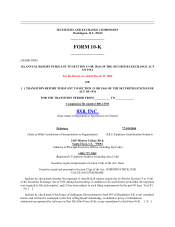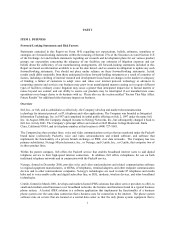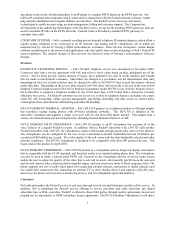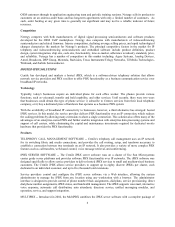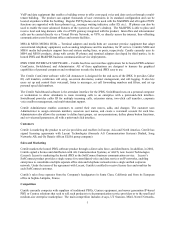8x8 2003 Annual Report Download - page 9
Download and view the complete annual report
Please find page 9 of the 2003 8x8 annual report below. You can navigate through the pages in the report by either clicking on the pages listed below, or by using the keyword search tool below to find specific information within the annual report.6
OEM customers through its application engineering team and periodic training sessions. Netergy sells its products to
customers on an order-to-order basis and has long-term agreements with only a limited number of customers. As
such, order backlog at any given time is generally not significant and may not be a reliable indicator of future
revenues.
Competition
Netergy competes with both manufacturers of digital signal processing semiconductors and software products
developed for the OEM VoIP marketplace. Netergy also competes with manufacturers of videoconferencing
semiconductors and related firmware. Intense competition, declining average selling prices, and rapid technological
changes characterize the markets for Netergy’s products. The principal competitive factors in the market for IP
telephony and videoconferencing semiconductors and embedded software include product definition, product
design, system integration, chip size, code size, functionality, time-to-market, adherence to industry standards, price,
and reliability. Netergy has a number of competitors in this market including: Agere Systems, Analog Devices,
Atmel, Broadcom, DSP Group, Motorola, Radvision, Texas Instruments/Telogy Networks, TriMedia Technologies,
Winbond, and Zarlink Semiconductor.
HOSTED IPBX SOLUTIONS
Centile has developed and markets a hosted iPBX, which is a software-driven telephony solution that allows
network service providers and PBX resellers to offer PBX functionality as a business communication service over
broadband IP networks.
Technology
Typically, today's businesses require an individual phone for each office worker. The phones provide various
functions, such as voicemail, transfer and hold capability, and other services. Until recently, there were two ways
that businesses could obtain this type of phone service: i) subscribe to Centrex services from their local telephone
company, or ii) buy a dedicated piece of hardware that operates as a business PBX system.
With the availability of broadband IP connectivity to businesses, however, a third alternative has emerged: hosted
iPBX services. In this model, the service provider delivers PBX functionality over an IP connection, which reduces
the scaling problems by allowing many extensions to share a single connection. This solution also offers many of the
advantages of an enterprise-owned PBX and further enables integration with enterprise data processing systems and
support of call centers, while eliminating the capital and maintenance investments required for dedicated on-site
hardware that provides the PBX functionality.
Products
TELEPHONY CALL MANAGEMENT SOFTWARE -- Centile's telephony call management uses an IP network
for its switching fabric and media connections, and provides the call routing, setup, and teardown necessary to
establish a connection between two terminals on an IP network. It also provides a variety of more complex PBX
features such as call transfers, web-based control, voice message retrieval, and conferencing.
IPBX SERVER SOFTWARE -- The Centile iPBX server software runs on a cluster of five Sun Microsystems
carrier grade server platforms and provides software PBX functionality over IP networks. The iPBX software was
designed specifically to allow service providers to deliver hosted iPBX services to small and medium-sized business
customers. The Centile iPBX allows service providers to support up to eighty discrete iPBXs per cluster, each
dedicated to an individual customer, and up to five thousand total extensions.
Service providers control and configure the iPBX server software via a Web interface, allowing the system
administrator to manage the iPBX from any location using any workstation with a browser. The administrator
interface is designed to provide control of phone number block assignments, dial plans, service provisioning, direct
dial phone number assignments, iPBX status, and bandwidth management. The iPBX supports voicemail, interactive
voice response, automatic call distribution, auto attendants, directory service, unified messaging modules, and
operation, service, and support integration.
MULTIPBX -- Introduced in 2002, the MultiPBX combines the iPBX server software with a complete package of

